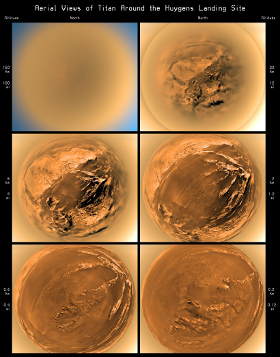Science highlights from Huygens:
#6. Hazy Titan
The measurements of the Descent Imager/Spectral Radiometer (DISR) on the Huygens probe provided in situ information on the optical properties, size and density of the haze particles. The observations showed that there was a significant amount of haze at all altitudes throughout the descent, extending all the way down to the surface.
 |
| Six stereographic images of Titan's surface taken during Huygens's descent to Titan's surface, showing the haze clearing. Credit: ESA/NASA/JPL/University of Arizona |
With decreasing altitude, the haze particles became brighter, and the particle sizes increased, due to collisions which resulted in a 'snowball' effect, as well as condensation of methane, ethane and hydrogen cyanide gases onto small aerosol nuclei at lower levels.
Huygens detected three distinct haze regions (region I above 80 km, region II between 80 and 30 km, and region III between 30 km and the surface), based on the density and optical properties of the atmosphere.
Before the Huygens mission, it was generally believed that the tiny haze particles slowly sink through the stratosphere, eventually acting as condensation nuclei for lower-level clouds. Some scientists theorised that the haze might clear below an altitude of 50 km to 70 km due to condensation of gases such as methane. However, the probe’s Descent Imager/Spectral Radiometer (DISR) showed that Huygens began to emerge from the haze only in the troposphere, 30 km above the surface.
Another thin layer of methane haze was detected at an altitude of 21 km, where the local temperature was -197 °C and the pressure was 450 mbar. This feature may be an indication of methane condensation. Indeed, the data suggest the presence of layered methane clouds in Titan's troposphere, at altitudes between 8 km and 30 km.
When combined with ground-based measurements, the data suggest an upper methane ice cloud (or haze) between approximately 20 km and 30 km and a liquid methane-nitrogen cloud layer between 8 km and 16 km, perhaps with a gap in between.




